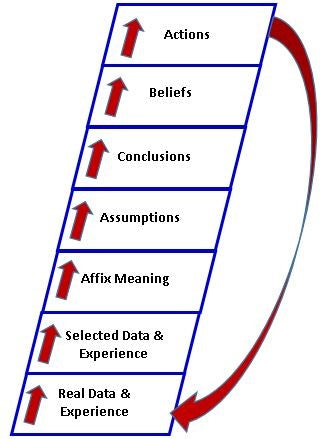Ladder of Inference
Ladder of Inference
Have you ever noticed how people can look at same facts and make radically different conclusions? And with so many “right” answers, it often becomes difficult to come together to get anything accomplished.
Of course you have, it happens all the time, not only at work, but in many aspects of our lives.
Why does this happen? And more importantly, what can we do about it?
The solution to this challenge lies in understanding The Ladder of Inference.
The concept was first introduced to me in Peter Senge's The Fifth Discipline: The Art and Practice of the Learning Organization. It was a theory developed by famed Organizational theorist Chris Argyris.
Simply put, the Ladder of Inference teaches how our expectations help us not only believe things that are not true, but reinforce our misconception.
Here is the Ladder of Inference:

We see Real Data and Experience through our personal bias. This limits what we choose to see and influences the Selected Data & Experience we select. The tendency is to select data that supports our own beliefs.
We use the data we select to Affix Meaning and make Assumptions. This leads us to draw Conclusions, which in turn will reinforce our Beliefs and will determine how we finally Take Action.
Our actions lead to new Real Data & Experience, which leads to the cycle occurring again and again. Like climbing a ladder, the further we get from where we started, the harder it is to see the ground, or in this instance, the real data we started with.
Another challenge is that every time we go through the ladder, it actually reinforces what we believe and can make our Beliefs even more rigid. This, in turn, causes the Selected Data & Experience we pay attention to become a smaller and smaller portion of reality. If you have ever wondered how seemingly intelligent people can make bad decisions, this is how it happens.
How do we stop short circuiting reality and begin to see reality for what it really is?
Here are three ideas:
- Develop a clear understanding of who we are and what we believe. This cannot be accomplished alone and requires a willingness to seek the thoughts of others and see oneself in an unvarnished way.
- Challenge all assumptions. Is what we believe based on fact or hearsay?
- Be willing to ask what other possibilities might be true? When something happens, either good or bad, too often we cling to only one answer and ignore other possibilities. As you learn to look for other options, you will be surprised by the possibilities.
Everyone is impacted by the Ladder of Inference. Understanding how it influences your decisions allows you to challenge your assumptions before they lead to poor actions. Understanding how it impacts others can help you develop ways to challenge their beliefs and see new possibilities.